Changing your guitar strings is a fundamental part of guitar maintenance that every player needs to learn. Fresh strings can dramatically improve your guitar’s tone, making it sound brighter and more resonant. Whether you’re a beginner or an experienced player, knowing how to Restring A Guitar properly will save you time and money, and keep your instrument sounding its best. This guide will walk you through each step of the process, ensuring you get it right every time.
Preparing Your Guitar for New Strings
Before you even think about opening that fresh pack of strings, it’s a perfect opportunity to give your guitar some much-needed attention. With the strings off, you have full access to areas that are usually tricky to reach. This is the ideal time for a deep clean. Dust and grime can build up on your fretboard, bridge, and even under the saddle.
 Guitar body cleaned, ready for new strings
Guitar body cleaned, ready for new strings
Take a soft cloth and gently wipe down the entire guitar, paying particular attention to the fretboard, bridge, saddle, and scratchplate (if your guitar has one). Removing this build-up will not only improve the look of your guitar but can also contribute to its overall health and longevity.
Conditioning the Fretboard with Lemon Oil
If your guitar has a dark wood fretboard, like rosewood or ebony, now is an excellent time to hydrate the wood with lemon oil. These denser woods can dry out over time, especially in drier climates, which can lead to cracks and other issues. Lemon oil helps to moisturize the wood, keeping it healthy and preventing potential problems.
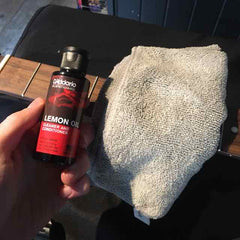 Applying lemon oil to a guitar fretboard
Applying lemon oil to a guitar fretboard
Apply a few drops of lemon oil to a clean cloth. Make sure to use actual lemon oil designed for guitars, not household cleaning products. Gently work the oil into the fretboard wood, moving up and down each fret. Don’t wipe it all away immediately; allow a small amount to soak into the wood for about 30 seconds.
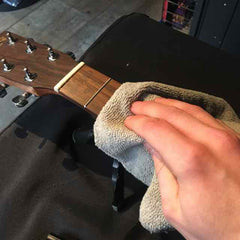 Lemon oil soaking into the fretboard
Lemon oil soaking into the fretboard
After allowing it to soak in slightly, use a clean part of the cloth to wipe away any excess lemon oil. Your fretboard should now look and feel refreshed. You can also apply a tiny amount of lemon oil to the bridge if it appears dry, but be careful to avoid the saddle itself, as oil on the saddle can cause strings to slip and affect tuning stability. Remember to remove the saddle before oiling the bridge for best practice.
 Hydrating the guitar bridge with lemon oil
Hydrating the guitar bridge with lemon oil
Preparing Your New Guitar Strings
Now for the exciting part – getting ready to install your new strings! Open your new pack of guitar strings and take a moment to identify the order in which they should be installed. String packs are usually arranged in order, from thickest to thinnest, which corresponds to the standard tuning from low E to high E. Knowing the correct order is crucial for restringing your guitar correctly and achieving proper tuning.
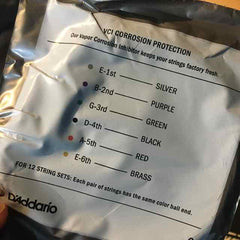 New guitar strings pack, showing string order
New guitar strings pack, showing string order
Before inserting the strings into the bridge, it’s a good practice to create a slight bend at the ball end of each string. A 45-degree bend can help ensure that the ball end sits snugly against the bridge plate inside the guitar body. This small step can significantly improve tuning stability and prevent string slippage.
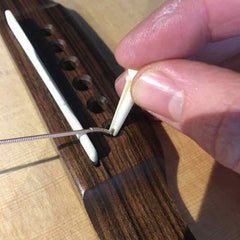 Bending the ball end of a guitar string
Bending the ball end of a guitar string
Inserting Strings into the Bridge
Now, take your first string (usually the low E, thickest string) and insert the ball end into the corresponding bridge hole. Use the bridge pin to push the ball end down securely. It’s vital to ensure that the tail of the string sits in the groove of the bridge pin and that this groove is facing directly down towards the guitar’s neck. This alignment ensures proper string tension and prevents buzzing or other issues.
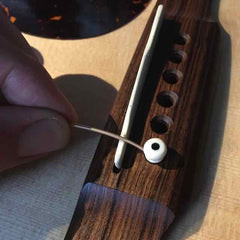 Inserting string and bridge pin into the guitar bridge
Inserting string and bridge pin into the guitar bridge
Repeat this process for each of the remaining strings, working your way across the bridge. After inserting each string and pin, gently pull on the tail of the string to confirm that the ball end is firmly seated against the bottom of the bridge plate. This ensures proper string anchoring and prevents slippage.
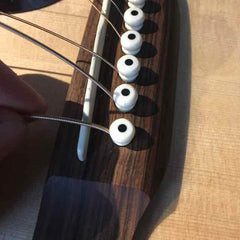 All strings inserted into the bridge with pins
All strings inserted into the bridge with pins
Stringing the Machine Heads
Before threading the strings through the machine heads, make sure the holes in each machine head are aligned straight down the neck of the guitar. This positioning will make string insertion easier and ensure smoother winding.
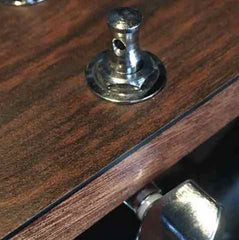 Machine head holes aligned downwards
Machine head holes aligned downwards
Now, take the string and guide it over the saddle, across the nut, and finally through the hole in the corresponding machine head. Pull the string through, leaving enough slack to wind around the tuning post.
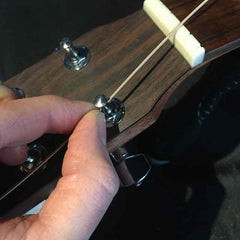 Threading the string through the machine head
Threading the string through the machine head
A useful tip for optimal tuning stability is to measure the string length before winding. Pull the string taut and measure up to the next machine head along the headstock. This length of extra string will provide enough winds around the tuning post, typically around 2-3 winds, which is ideal for maintaining tuning.
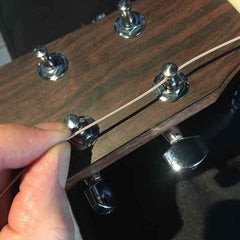 Measuring string length for winding
Measuring string length for winding
Pull the measured excess string back through the machine head post. Begin winding the machine head counter-clockwise for the lower strings (E, A, D) and clockwise for the higher strings (G, B, e). Maintain some tension on the string as you wind, ensuring the measured slack remains consistent. Crucially, the string coming from the nut should always be on the inside of the tuning post.
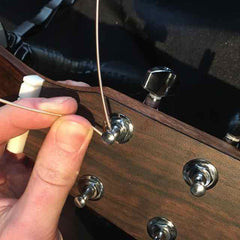 Winding the string around the machine head post
Winding the string around the machine head post
As you wind, ensure that the new string wraps go underneath the previous wrap, pushing them downwards towards the headstock. This technique creates a neat and secure string winding, which further enhances tuning stability and prevents slippage.
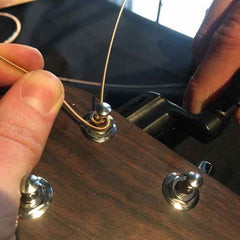 String wraps layered downwards on the machine head
String wraps layered downwards on the machine head
Continue winding until the string has a small amount of tension. A couple of winds around the post at this stage should be sufficient. You don’t need to bring it up to full pitch just yet.
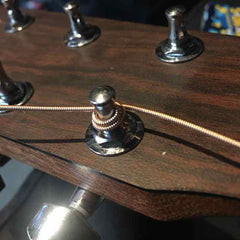 String with initial tension on the machine head
String with initial tension on the machine head
Once you have a few winds on the post, take wire cutters and trim off the excess string. Cut as close to the machine head post as safely possible for a cleaner look and to avoid getting poked by sharp string ends.
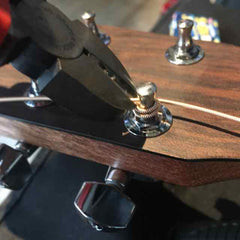 Trimming excess guitar string with wire cutters
Trimming excess guitar string with wire cutters
Tuning and Stretching Your New Strings
Repeat the stringing process for the remaining five strings, generally working from the thickest string to the thinnest. Once all the strings are installed, it’s time to bring them up to pitch.
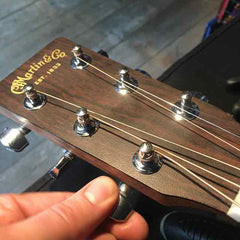 All six strings installed on the guitar
All six strings installed on the guitar
Use a guitar tuner (a clip-on tuner is shown here, but any tuner will work) to tune each string to its correct pitch. Bring the strings up to pitch gradually, moving back and forth between each string. This prevents excessive tension on the neck in one area and helps to distribute the overall tension evenly across the neck.
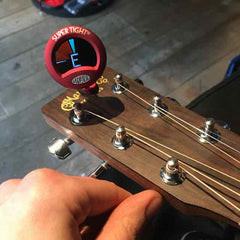 Tuning the guitar with a clip-on tuner
Tuning the guitar with a clip-on tuner
New strings need to be stretched. Stretching is a crucial step to prevent your guitar from constantly going out of tune. Gently stretch each string by pulling it away from the fretboard in the middle, then retune. Repeat this process several times for each string until they hold their pitch after stretching. This process breaks in the strings quickly, saving you time and frustration in the long run. After stretching and re-tuning, your guitar should be ready to play!
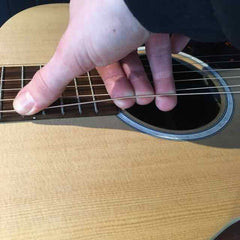 Stretching new guitar strings
Stretching new guitar strings
Now you know how to restring a guitar like a pro! Enjoy the bright, clear sound of your newly strung guitar and get back to playing your favorite tunes.
